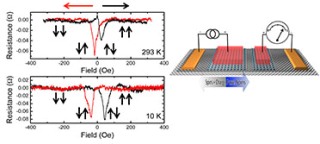Jul 20 2015
Scientists at the U.S. Naval Research Laboratory (NRL) have created a new type of room-temperature tunnel device structure in which the tunnel barrier and transport channel are made of the same material, graphene. Such functionalized homoepitaxial structures provide an elegant approach for realization of graphene-based spintronic, or spin electronic, devices. The research results are reported in a paper published in the journal ACS Nano (DOI: 10.1021/acsnano.5b02795).
 Low temperature and room temperature operation of the homoepitaxial graphene spin valve (left) and a schematic (right) of one of the homoepitaxial fluorinated graphene/graphene spin valve devices. Distinct steps in the resistance appear at the coercive fields of the ferromagnetic contacts, producing plateaus of higher resistance when the ferromagnetic contact magnetizations are antiparallel, as indicated by the black arrows. Only a 50% decrease in magnitude is observed from 10 K to room temperature. The top layers of graphene are used as a tunnel barrier. It is hydrogenated to decouple it from the bottom layer of graphene, which is the spin transport channel. Ferromagnetic permalloy (NiFe - red) contacts inject and detect the spin in the channel. The gold contacts are ohmic reference contacts (Ti/Au).
Low temperature and room temperature operation of the homoepitaxial graphene spin valve (left) and a schematic (right) of one of the homoepitaxial fluorinated graphene/graphene spin valve devices. Distinct steps in the resistance appear at the coercive fields of the ferromagnetic contacts, producing plateaus of higher resistance when the ferromagnetic contact magnetizations are antiparallel, as indicated by the black arrows. Only a 50% decrease in magnitude is observed from 10 K to room temperature. The top layers of graphene are used as a tunnel barrier. It is hydrogenated to decouple it from the bottom layer of graphene, which is the spin transport channel. Ferromagnetic permalloy (NiFe - red) contacts inject and detect the spin in the channel. The gold contacts are ohmic reference contacts (Ti/Au).
The NRL team shows that hydrogenated graphene, a hydrogen-terminated single atomic layer of carbon atoms arranged in a two-dimensional honeycomb array, acts as a tunnel barrier on another layer of graphene for charge and spin transport. They demonstrate spin-polarized tunnel injection through the hydrogenated graphene, and lateral transport, precession and electrical detection of pure spin current in the graphene channel. The team further reports higher spin polarization values than found using more common oxide tunnel barriers, and spin transport at room temperature.
In spite of nearly a decade of research on spin transport in graphene, there has been little improvement in important metrics such as the spin lifetime and spin diffusion length, and reported values remain far below those predicted by theory based on graphene's low atomic number and spin-orbit coupling. Understanding the extrinsic limiting factors and achieving the theoretically predicted values of these metrics is key for enabling the type of advanced, low-power, high performance spintronic devices envisioned beyond Moore's law. Scattering caused by tunnel barriers, which are essential for solving the conductivity mismatch problem for electrical spin injection from a ferromagnetic metal into a semiconductor, is a topic that is just now attracting attention. Uniform, pinhole/defect free tunnel barriers on graphene are not easily attained with the conventional methods that use oxides.
Hydrogenation of graphene offers an alternative method to achieve a homoepitaxial tunnel barrier on graphene. In contrast with fluorination and plasma treatments, the chemical hydrogenation process developed by team member Dr. Keith Whitener provides a rapid, gentler and more stable functionalization with much higher hydrogen coverage. Moreover, recent studies, also by NRL teams, show that hydrogenated graphene could be magnetic, which could be used to control spin relaxation in the graphene. Because of its extremely low spin-orbit coupling, such control has been difficult. "These new hydrogenated graphene homoepitaxial devices solve many of the issues plaguing graphene spintronics and, with the room temperature operation and possible control with magnetic moments, offer distinct advantages over previous structures for integration with modern electronics architectures," explains Dr. Adam Friedman, lead author of the study.
The NRL scientists use chemical vapor deposition to grow and then sequentially deposit a four-layer (only 4 atoms thick) graphene stack. They then hydrogenate the top few layers so that they serve as a tunnel barrier for both charge and spin injection into the lower graphene channel. They deposit ohmic (gold) and ferromagnetic permalloy (red) contacts as shown in the figure, forming a non-local spin valve structure. When the scientists apply a bias current between the left two contacts, a spin-polarized charge current tunnels from the permalloy into the graphene transport channel, generating a pure spin current that diffuses to the right. This spin current is detected as a voltage on the right permalloy contact that is proportional to the degree of spin polarization and its orientation. The vectorial character of spin (compared to the scalar character of charge) provides additional mechanisms for the control and manipulation needed for advanced information processing. The NRL team demonstrated the higher spin injection efficiency (16.5%) than most previous graphene spin devices, determined spin lifetimes with the Hanle effect, and observed only a 50% loss in spin valve signal from 10 K to room temperature (left graph).
The NRL research team includes Dr. Adam Friedman, Dr. Olaf van't Erve, and Dr. Berend Jonker from the Materials Science and Technology Division, Dr. Jeremy Robinson from the Electronics Science and Technology Division, and Dr. Keith Whitener, Jr. from the Chemistry Division.